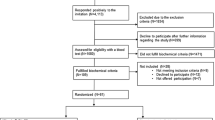Abstract.
The long-term effects on bone of estrogen therapy (HRT) combined with vitamin D3 supplementation were evaluated and compared with the effects of HRT without vitamin D3 supplementation in a 4-year prospective, partly randomized study among 60 osteoporotic women (mean age 55.4 years; range 49.7–59.4 years). The women studied were a subgroup of the population-based Kuopio Osteoporosis Risk Factor and Prevention Study (OSTPRE) (n = 13100). The bone mineral densities (BMD) of the lumbar spine and femoral neck were determined by dual-energy X-ray absorptiometry (DXA) in 3236 perimenopausal women. Those 106 women with baseline BMD more than 2 SDs less than the mean value in this population, either at the lumbar spine (BMD < 0.826 g/cm2) and/or femoral neck (BMD < 0.684 g/cm2), were offered treatment for osteoporosis. After exclusions, 60 women were included in the analyses. Group allocation was: HRT (estradiol valerate (2 mg) plus cyproterone acetate, 1 mg, sequentially: ClimenR) (n = 21); HRT + Vit D: Climen + vitamin D3 (cholecalciferol, 300 IU/day, no intake during June–August) (n = 23); controls: 16 women who refused all treatment served as a non-randomized control group. In the HRT group, the highly significant increase in lumbar BMD was 5.4%, 5.3%, 4.7% and 4.0% after 1, 2, 3 and 4 years of treatment, respectively, all compared with the baseline values and with the control group. The increase in femoral neck BMD was statistically insignificant (1.4%, 2.2%, 1.9% and 2.1%, respectively; p > 0.05). In the HRT + Vit D group, the lumbar BMD increased by 3.7%, 4.9%, 4.9% and 4.9% (p < 0.001), whereas the 5.8% increase in femoral neck BMD reached significance at 4 years (p < 0.01) when compared with the control group as well as with the baseline values. However, there were no statistically significant differences in lumbar or femoral BMD changes between the two HRT groups. In conclusion, estrogen can substantially increase lumbar bone mass in patients with postmenopausal osteoporosis. In addition, the combination of HRT and vitamin D3 may increase femoral neck BMD in osteoporotic women more than estrogen alone.
Similar content being viewed by others

Author information
Authors and Affiliations
Additional information
Rights and permissions
About this article
Cite this article
Tuppurainen, M., Komulainen, M., Kröger, H. et al. Does Vitamin D Strengthen the Increase in Femoral Neck BMD in Osteoporotic Women Treated with Estrogen?. Osteoporos Int 8, 32–38 (1998). https://doi.org/10.1007/s001980050045
Issue Date:
DOI: https://doi.org/10.1007/s001980050045



